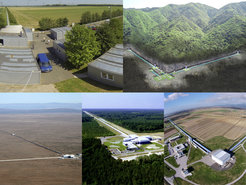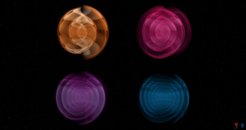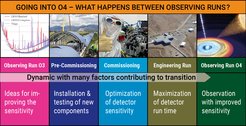Gravitational-wave detectors prepare for next observing run
The LIGO-Virgo-KAGRA collaboration is making progress towards the start of the next observing run.
After three years of work to improve the performance of the detectors, Observing Run 4 (O4) is expected to start on May 24th, 2023. The detectors continue to make progress towards their O4 sensitivity goals and the LIGO detectors just moved from commissioning to the Engineering Run (ER15) which needs to be completed before Observing Run 4 can begin. Virgo is also joining the Engineering Run, but for a limited fraction of time, giving priority to commissioning activities aiming at improving the sensitivity. KAGRA has not started the Engineering Run, but will continue commissioning to improve the sensitivity until the start of O4.
The aim of this collaborative Engineering Run is to test the upgraded instruments in real time and, especially, the systems required for the network of detectors to observe together. The latest major upgrades to the LIGO and Virgo instruments will result in more sensitive detectors, capable of sensing even ‘fainter’ gravitational waves — which also means detecting more events than ever before.

The LIGO detectors are operating near their planned sensitivity goal of 160 Mpc. To achieve the target sensitivity of about 80 Mpc, Virgo will schedule an additional commissioning period at the beginning or during the run. The exact timing and duration will be decided based on the status of the detector and is currently under discussion. KAGRA, which employs some unique forward-looking and challenging detection technology, has reached the planned minimum sensitivity of 1 Mpc for the beginning of O4. After one month of observing run at the beginning of O4, KAGRA will return to commissioning works to improve its sensitivity toward the end of O4. GEO600, the German-British detector, having provided observational coverage during the upgrades of the other instruments, has been engaged in maintenance and will continue to operate with a sensitivity of about 1.2 Mpc during the run. It will fill maintenance gaps from the other detectors while developing technologies for the future. All large gravitational-wave detectors in the world now use technologies developed and tested at GEO600.
We expect to see events during the engineering run; if any exceptional candidate events (having a particularly strong signal, especially if they are likely to be associated with an electromagnetic counterpart) occur, they will be released to the scientific community via GraceDB (Gravitational-Wave Candidate Event Database) and GCN (General Coordinates Network) and studied further.

Ever more accurate waveform models and novel data-analysis methods developed at the Max Planck Institute for Gravitational Physics during the last three years will be crucial for extracting the signals from the data stream, identifying the sources, and inferring their astrophysical and cosmological properties.
O4 will comprise 18 months of active observing time, extending into 2025. The 18 month observing period may be interleaved with one or two month-scale gaps for maintenance. The extended run time will increase the scientific output of O4 and allow additional time for the preparation of upgrades for the O4-O5 break.
From commissioning to engineering runs and observing runs
Gravitational-wave detectors go through several phases to improve sensitivity, while ensuring this is balanced with collecting data. After the completion of maintenance and installation of planned upgrades during pre-commission the detectors transition into a commissioning phase. During the commissioning phase, the focus is on integrating the individual upgrades into a whole detector operating as close to the design sensitivity as possible.
Once the commissioning team is satisfied with the performance of the detectors they move into an engineering run where the goal is to achieve the highest duty cycle or uptime (the time the detector is capable of taking observing data) before ultimately entering the observing run. The transition between phases is a dynamic process with many factors contributing to the decision to shift from one phase to the next.

Gravitational-wave observatories
LIGO is funded by the NSF, and operated by Caltech and MIT, which conceived and built the project. Financial support for the Advanced LIGO project was led by NSF with Germany (Max Planck Society), the U.K. (Science and TechnologyFacilities Council) and Australia (Australian Research Council) making significant commitments and contributions to the project. More than 1,400 scientists from around the world participate in the effort through the LIGO Scientific Collaboration, which includes the GEO Collaboration. Additional partners are listed at http://ligo.org/partners.php.
The Virgo Collaboration is currently composed of approximately 846 members from 142 institutions in 15 different (mainly European) countries. The European Gravitational Observatory (EGO) hosts the Virgo detector near Pisa in Italy, and is funded by Centre National de la Recherche Scientifique (CNRS) in France, the Istituto Nazionale di Fisica Nucleare (INFN) in Italy, and the National Institute for Subatomic Physics (Nikhef) in the Netherlands. A list of the Virgo Collaboration groups can be found at http://public.virgo-gw.eu/the-virgo-collaboration/. More information is available on the Virgo website at https://www.virgo-gw.eu.
KAGRA is the laser interferometer with 3 km arm-length in Kamioka, Gifu, Japan. The host institute is the Institute of Cosmic Ray Researches (ICRR), the University of Tokyo, and the project is co-hosted by National Astronomical Observatory of Japan (NAOJ) and High Energy Accelerator Research Organization (KEK). KAGRA collaboration is composed of over 480 members from 115 institutes in 17 countries/regions. KAGRA's information for general is at the website https://gwcenter.icrr.u-tokyo.ac.jp/en/. Resources for researchers are accessible from http://gwwiki.icrr.u-tokyo.ac.jp/JGWwiki/KAGRA.














